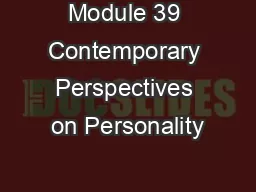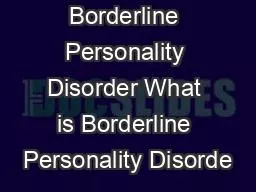PPT-Module 39 Contemporary Perspectives on Personality
Author : trish-goza | Published Date : 2018-11-08
391 HOW DO PSYCHOLOGISTS USE TRAIT THEORIES TO DESCRIBE PERSONALITY Trait theorists see personality as a stable and enduring pattern of behavior They describe
Presentation Embed Code
Download Presentation
Download Presentation The PPT/PDF document "Module 39 Contemporary Perspectives on P..." is the property of its rightful owner. Permission is granted to download and print the materials on this website for personal, non-commercial use only, and to display it on your personal computer provided you do not modify the materials and that you retain all copyright notices contained in the materials. By downloading content from our website, you accept the terms of this agreement.
Module 39 Contemporary Perspectives on Personality: Transcript
391 HOW DO PSYCHOLOGISTS USE TRAIT THEORIES TO DESCRIBE PERSONALITY Trait theorists see personality as a stable and enduring pattern of behavior They describe differences rather than trying to . CONTEMPORANEITY. /PLANETARITY:. CHARTS. TERRY SMITH. 2011. CONTEMPORARY WORLD CURRENTS . . CONTINUING MODERNITIES . Globalization. , Post-Cold War Hyperpower; Clash of. Civilizations. , Spectacularity. Poetry. . and . Drama. : Dr. Natália . Pikli. Prose. : Dr. Zsolt . Czigányik and. Dr. Ákos Farkas. 1, . September. 9. . Orientation. 2, . September. . 16 . Ted . Hughes. 3. , . September. . 1950 – Present. How Did it Come About?. The aftermath of WW II ushered in an age of rapid developments in science and technology.. The postwar years offered many Americans increased opportunities for economic and cultural growth, but the individual person seems lost in the fast-paced, computerized world.. Read pg. 477-478 (top) featuring a very unique personality, Steve Irwin. Read the selection with this question . in mind. : . Which traits characterized Irwin’s personality? . Why does personality form? In other words, what are the major forces that make people “who they are?”. 4 5 Rescuing Scholars: Historical Perspectives, Contemporary Challenges IIE-SRF RAChroughout the twentieth century scholars and intellectuals have faced grim episodes of harassment, repression, violen Uni. -dimensional or Multi-dimensional. Theoretical . or Psychometric (data reduction). Factor Analysis or Criterion Reference. Normal or Abnormal Traits. Group or Individual Administration. Oral or Written. Hans Eysenck believed that we can describe people’s personalities by classifying them along two scales: . Introversion-extraversion scale. Stable-unstable . scale. The Big Five. Many contemporary trait theorists believe personality can be described using 5 traits:. 38-1: . WHAT THEORIES INFORM OUR UNDERSTANDING OF PERSONALITY?. Personality. : . An individual’s . characteristic pattern of thinking, feeling, and acting. Two historically significant personality theories:. Psychoanalytic. —importance of unconscious processes and childhood experiences. Humanistic. —importance of self and fulfillment of potential. Trait. —description and measurement of personality differences. Alice F. Short. Hilliard Davidson High School. Chapter Preview. Psychodynamic Perspectives. Humanistic Perspectives. Trait Perspectives. Personological and Life Story Perspectives. Social Cognitive Perspectives. nner . psychological characteristic . that reflect how a person . responds. to his/her environment.. Inner characteristics -can be specific personal . qualities, attributes, traits, mannerisms . that distinguish one individual from others. National Instituteof Mental HealthWhat are the signs and symptoms People with borderline personality disorder may experience mood swings and may display uncertainty about how they see themselves and t Maladaptive variations or combinations of normal personality traits. Extremes on either end of specific trait dimensions can be associated with disorders.. An enduring pattern of experience and behavior that differs greatly from society’s expectations. People with personality disorders have . formed peculiar and unpleasant personality patterns. . For example, some are very secretive, some very self-centered and selfish, some suspicious all the time. .
Download Document
Here is the link to download the presentation.
"Module 39 Contemporary Perspectives on Personality"The content belongs to its owner. You may download and print it for personal use, without modification, and keep all copyright notices. By downloading, you agree to these terms.
Related Documents














